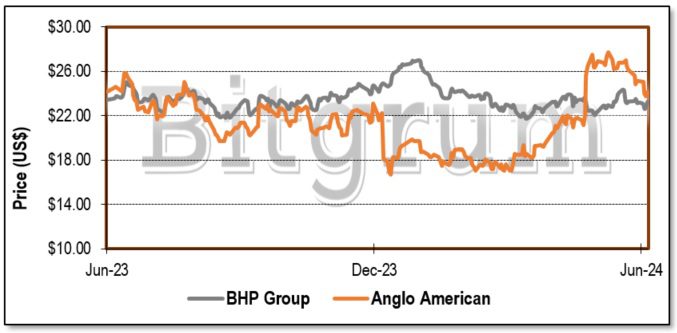In a recent move, BHP Group Ltd. (LON: BHP | ASX: BHP | NYSE: BHP) proposed an all-share takeover of Anglo American Plc (LON: AAL), valuing the smaller miner at approximately £31.1 billion, equivalent to US$38.8 billion.
This valuation, derived from a per-share offer price of £25.08, represented a 14% premium over Anglo’s closing share price pre-announcement. The proposal required Anglo to first divest its controlling stakes in its South African platinum and iron ore companies to shareholders before proceeding with the acquisition.
The market responded to the announcement with a notable 13% increase in Anglo’s share price, while BHP’s shares experienced a 3.7% decline. The proposed transaction was positioned by BHP as a strategic enhancement of its copper production capabilities.
Specifically, the deal aimed to provide BHP with approximately 10% of the global copper mine supply, a significant step given the anticipated supply shortages and the increasing global demand for copper, driven largely by the shift towards green technologies.
However, the proposed deal failed as Anglo’s board repeatedly rejected BHP’s offers, citing undervaluation and structural complexities. Regulatory challenges and shareholder concerns further complicated the deal, leading BHP to withdraw its proposal.
BHP was aware of the risk of overpaying, which could have adversely affected their financial health. Additionally, BHP had to consider the execution risks from the complex deal structure, particularly around the required divestitures of Anglo’s assets, regulatory uncertainties, and required synergies to justify a higher price.
Response from Anglo
Anglo’s board deemed the initial offer inadequate, prompting BHP to enhance the terms. Despite these revisions, the board remained unconvinced, asserting that the proposals still undervalued the company and misaligned with shareholder interests.
This stance was supported by various financial analysts and stakeholders, who suggested that a higher offer, potentially around £28 per share, might be necessary to initiate serious discussions.
This situation underscores the complexities involved in valuing such large-scale transactions, where strategic objectives must be balanced against shareholder expectations and market realities. The negotiations also highlighted the critical role of commodity valuations and operational synergies in shaping the financial metrics of potential mergers and acquisitions within the mining industry.
Strategic Objectives
BHP pursued the acquisition intending to bolster its position in the global copper market, primarily aiming to enhance its copper production capacity.
This strategic move was contextualized within the broader industry trend where demand for copper is expected to surge, largely fueled by the metal’s critical role in supporting the transition to renewable energy technologies and electrification.
The acquisition of Anglo was targeted as a strategic fit to achieve this objective, as it would have provided BHP with access to some of the largest copper mines in the world, thereby increasing its copper output by approximately 40%. This increment in capacity was anticipated to position BHP as a leading player in the copper industry, particularly at a time when market forecasts indicate potential copper shortages due to increased global demand.
Moreover, BHP’s strategy included a proposal to first allow Anglo to divest its holdings in certain South African entities, thereby streamlining the merger process and focusing on core assets which are pivotal to BHP’s long-term growth strategy in the copper sector. This approach highlights BHP’s targeted strategic planning aimed at enhancing its commodity portfolio while managing operational and regional risks associated with large-scale acquisitions.
Regulatory and Shareholder Challenges
The proposed acquisition faced significant regulatory and shareholder challenges, impacting its progress and feasibility.
Regulatory scrutiny was anticipated to be intense due to the scale of the merger and its potential impact on the global mining landscape, particularly in the strategic copper sector. Authorities were expected to examine antitrust issues closely, considering the combined entity would control a substantial portion of the global copper supply.
Shareholder response was mixed, with some Anglo shareholders viewing BHP’s offers as undervalued, thereby rejecting the proposal. Concerns were also raised about the complexity of the deal structure, which required Anglo to demerge significant South African assets, adding layers of uncertainty and execution risk.
These factors contributed to the shareholders’ hesitance, reflecting the critical role they play in the approval and success of major corporate transactions.
Figure 1: BHP and Anglo American – 1-Year Stock Chart

Market Implications
The attempted acquisition had notable implications for the mining sector, especially in the copper market.
Should the merger have succeeded, BHP would have significantly increased its copper production capacity, consolidating its position as a leading global player. This consolidation was likely to enhance BHP’s market influence, potentially driving broader industry pricing and supply dynamics.
Additionally, a successful merger would have catalyzed further consolidation in the sector, possibly triggering a wave of mergers and acquisitions as competitors sought to match BHP’s enhanced capabilities and market reach. Such industry dynamics underscore the strategic importance of copper in the global transition to renewable energy.
Global Economic and Commodity Trends
The global economic and commodity trends reveal BHP’s strategic focus on copper, critical in green technology and renewable energy sectors.
As the world intensifies its shift towards sustainable energy solutions, copper’s role becomes increasingly vital, given its essential use in electric vehicles, renewable energy systems, and infrastructure projects aimed at reducing carbon footprints.
This backdrop is part of a broader trend in the mining industry, which is moving towards consolidation as companies aim to bolster their resources to meet growing global demands. Such consolidation is not only a response to the increasing need for copper but also a strategic maneuver to enhance operational efficiencies and reduce costs amidst fluctuating commodity prices and economic uncertainties.
Moreover, the industry faces significant challenges, including geopolitical tensions and regulatory changes that impact mining operations, particularly in jurisdictions with rich mineral deposits.
Companies are therefore compelled to navigate these complexities while ensuring they remain competitive and capable of meeting the projected demands of a rapidly evolving global market. This scenario underscores the strategic imperatives that drive major mining companies to pursue mergers and acquisitions as a pathway to secure their positions in a competitive landscape.
What’s Next
Following the failed acquisition attempt of Anglo by BHP, both companies are poised to explore strategic alternatives to strengthen their market positions and future growth.
BHP’s initial intent to merge with Anglo was driven by the goal to significantly boost its copper production capabilities. However, with the termination of this deal, BHP may continue to seek other opportunities to expand its commodity portfolio, particularly in metals critical for green technologies.
Anglo, having resisted BHP’s proposals, remains focused on enhancing shareholder value through its existing operations and strategic initiatives. Anglo has considered strategic divestments as part of its broader restructuring efforts to streamline operations and focus on its most lucrative and strategic assets.
The divestment plan involves potentially separating non-core businesses, such as certain South African assets, to reduce complexity and concentrate on high-growth commodities like copper.
Such strategic realignments are intended to improve operational efficiencies and financial performance, while also making the company less susceptible to unsolicited takeover attempts by simplifying its corporate structure and focusing on key areas of growth.
Final Thoughts
The future outlook for both companies involves navigating the ongoing complexities of global supply and demand dynamics, particularly in the copper market, which is expected to remain robust due to its essential role in the energy transition.
Additionally, both firms are likely to continue investing in technology and sustainability initiatives to meet regulatory requirements and enhance their competitive edge in a market increasingly focused on environmental, social, and governance (ESG) factors.

